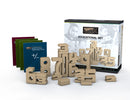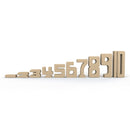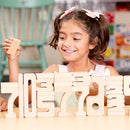Sumblox are a set of wooden blocks shaped in the numerals 1-10. Each block is proportional in size to the value of the number. So a 2 block is twice as tall as a 1 block and a 10 block is ten times as tall.
Description
⏳ Sale ends in {timer}
SumBlox mission is to bring about lasting change in education through the creation of powerful learning games. We believe that you don’t have to sacrifice learning content to make something fun!
This is the largest set available with 100 Blocks + 4 Lesson Books
A classroom set of SumBlox (100 blocks) plus 4 teaching manuals (Addition/Subtraction, Multiplication, Fractions, Adding Fractions; 50+ pages each w/ illustrations).
The world of maths in a building block.
By manipulating the blocks and stacking them in different combinations, children can learn to recognize numerals, explore addition and subtraction and practice basic multiplication, division, and fractions.
For what age are SumBlox best suited?
SumBlox are great for children and adults of all ages but are best suited, academically, for children ages 2-12.
What mathematical concepts can SumBlox teach?
Students can learn a wealth of information through play and hands-on exploration. These topics include:
Number Sense
- Number recognition
- One-to-one correspondence
- Compare numbers
- Subitizing
- Counting
- Cardinality
- Number sequence
- Hierarchical Inclusion
- Understanding our base-ten system
- Place value
- Measuring Lengths
- Reason abstractly and quantitatively
- Understand Equivalence
- Directly compare two objects with a measurable attribute in common
- Algebraic Thinking
- Describe measurable attributes of objects, such as length or weight
- Classify objects into given categories
Addition / Subtraction
- Solve Addition and Subtraction word problems using objects
- Compose and decompose numbers
- Find missing addends
- Skip counting
Multiplication / Division
- Define multiplication; emphasis on multiples
- Find factors of whole numbers and use commutative property of multiplication
- Classify whole numbers (greater than one) as prime or composite
- Draw conclusions about the factors of a whole number
- Use associative property of multiplication
- Use distributive property of multiplication
Fractions / Adding Fractions
- Define denominator of fractions
- Define numerator of fractions within halves, fourths, and eights
- Find equivalent fractions within thirds, sixths, ninths, and twelfths
- Compare two fractions using inequality symbols
- Compare and order three fractions using compound inequalities
- Find the value of a fraction of a whole number
- Find the fraction, or part, a given value is of a whole value
- Add two fractions with the same denominator to get a sum up to one whole and fully decompose a given fraction
- Add two fraction addends with the same denominator to get a sum greater than one whole
- Add multiple fraction addends to find sums greater than one whole and represent sums in improper form and mixed numbers
- Add two fraction addends with different denominators (only having to scale one of the addends)
- Add three fraction addends with different denominators (only having to scale two of the addends)
- Add two fractions addends with different denominators (having to scale all addends to find a common denominator)
Payment & Security
Your payment information is processed securely. We do not store credit card details nor have access to your credit card information.


















